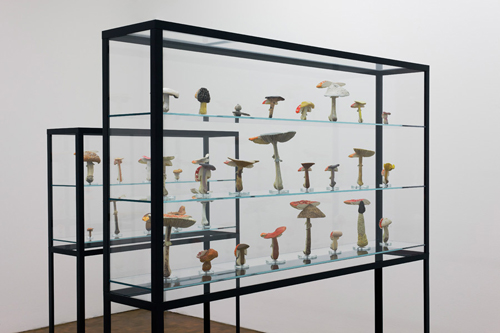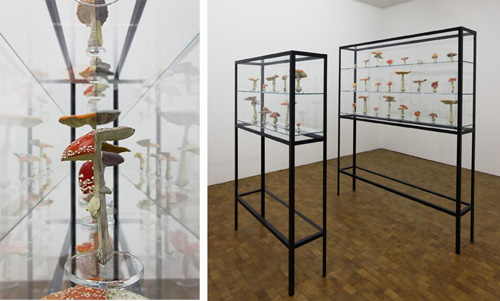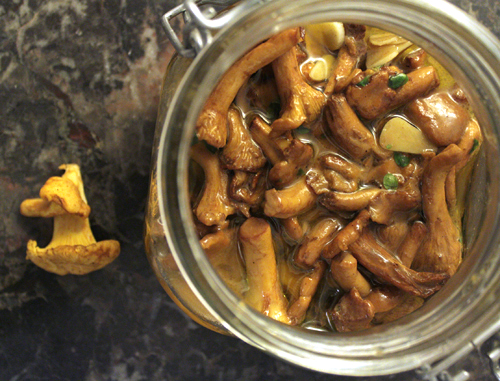Beautiful butterflies, stunning flowers, and fruiting trees attract and deflect attention with their often intricate colouration. Targeted for particular audiences, a single color can carry conflicting messages. In nature, orange signals vitamin rich potency and likewise poisonous lethal doses, though it also functions simply as a scare tactic. In works by artist Carsten Höller, orange mushroom caps recall (in gross scales) the natural poisons they indicate. In his 2009 work, Doppelpilzvitrine (24 Doppelpilze) (and in his recent large-scale sculptural installation, Doppelpilzuhr), Höller replicates spliced mushroom pairings in such scientific detail it is difficult to draw the line between artistic endeavor and experimental inquiry. The orange of these mushrooms, the fly amanita, which are the common denominator of his mushroom works, acts as a sign-posting of their Gift. (Gift is German for poison.) Their presentation in pristine glass cases cites research and archival collections, while their grafted halves belay their sequential categorization. From one side of the vitrine an assortment of fungi in varying shapes and sizes are visible, while from the other side the bright orange and white speckled specimens of the rare fly amanita dominate the view.

145 x 25 x 175 cm, Photo (of side-view): Carsten Eisfeld, Courtesy: Esther Schipper
In Carsten Hölller’s current solo exhibition in Berlin’s Hamburger Bahnhof, Soma, the artist furthers his investigation of the fly amanita, a psychodelic mushroom that is hypothesized as being the main ingredient in the ancient revered drink of the gods, Soma. The installation comprises the corralling of 12 reindeer being fed their natural diet of fly amanita and an omnipresent proposal to feed their distilled urine to canaries and mice in an outlined double-blind experiment. Evident in the exhibition’s setup, Höller’s artistic practice continually incorporates his scientific career through petri dish-like pedestals, sterile displays, and a dichotomy of observation and the behavior of nature.

To somehow pair a meal with such a splicing of nature itself could turn tricky (and quickly topsy turvy). In keeping a relationship to the color and display of Höller’s mushroom caps, this recipe for marinated chanterelles follows a pattern of preservation long lived in culinary history – a science in itself. One of the most stunning aspects of the show at the Hamburger Bahnhof is the colour change from the brilliant orange of the fresh shrooms to the pulpy browns of those frozen and stacked in blue plastic sacks within the installation. This natural decomposition, although averted by temperature, solutions and even marinades, affirms the ephemeral nature of pigments and the break down of colour in foods.

Working with a beloved recipe duly attributed to a Berkeley chef, Paul Johnston, the vibrant orange of Germany’s freshly foraged chanterelles meld into buttery yellows and golden mustards after a quick flash in the pan. Like Höller’s intrigue in the elusive Soma recipe, the chanterelle, though popular, is a mushroom that retains its allure by its very selectivity. Although attempted manifold, the chanterelle is yet to be cultivated. It remains a feature of the wilderness, linking the craze for these meaty bites with the perfect conditions of rain and warmth. When the mushrooms emerge, they are harvested by nimble fingers found by keen eyes seeking out their telling orangey flesh amongst the browns of fallen leaves. But, be warned, like the precisely painted rows of polyurethane mushrooms in Höller’s work, the slight imperfections and characteristic colour of a tasty chanterelle can be startlingly well matched by clever (and often poisonous) look-a-likes!

Marinated Chanterelles
4-6 tablespoons extra virgin olive oil
250 g chanterelles, picked clean (do not wash) and sliced generously
Sauté chanterelles briskly in hot oil – just under 5 minutes. Pour, with remaining oil, into a sealable glass jar.
Marinade:
2 tablespoons balsamic vinegar
2 garlic cloves, thinly sliced
1 bay leaf
1 teaspoon Dijon mustard
1/2 teaspoon fresh marjoram (oregano can be substituted here)
1/4 teaspoon sea salt
Whisk together marinade and pour over sautéed mushrooms. Seal jar and marinate for at least 4 hours in the refrigerator before serving. Eat within 2 weeks. Serve atop fresh salad (works very well paired with mild chèvre), drizzled over wild rice or alone as an appetiser.
Cassandra Edlefsen Lasch is a Berlin-based art historian and artist advisor active within international contemporary art production and project realisation. Investigating collaboration is central to her work and her recipes are all gluten-free.
………………………………………………..

4 comments
Rosa says:
Dec 8, 2010
Those marinated chanterelles look divine! What a delightful exhibition.
Cheers,
Rosa
siri says:
Dec 8, 2010
Yum. Just yum.
Julie says:
Dec 9, 2010
Gorgeous color in those chanterelles.
Forager @ The Gourmet Forager says:
Dec 9, 2010
Fantastic! An art installation truly up my alley. I’d love to see this.. and eat your yummy marinated chanterelles! I wish they grew here!